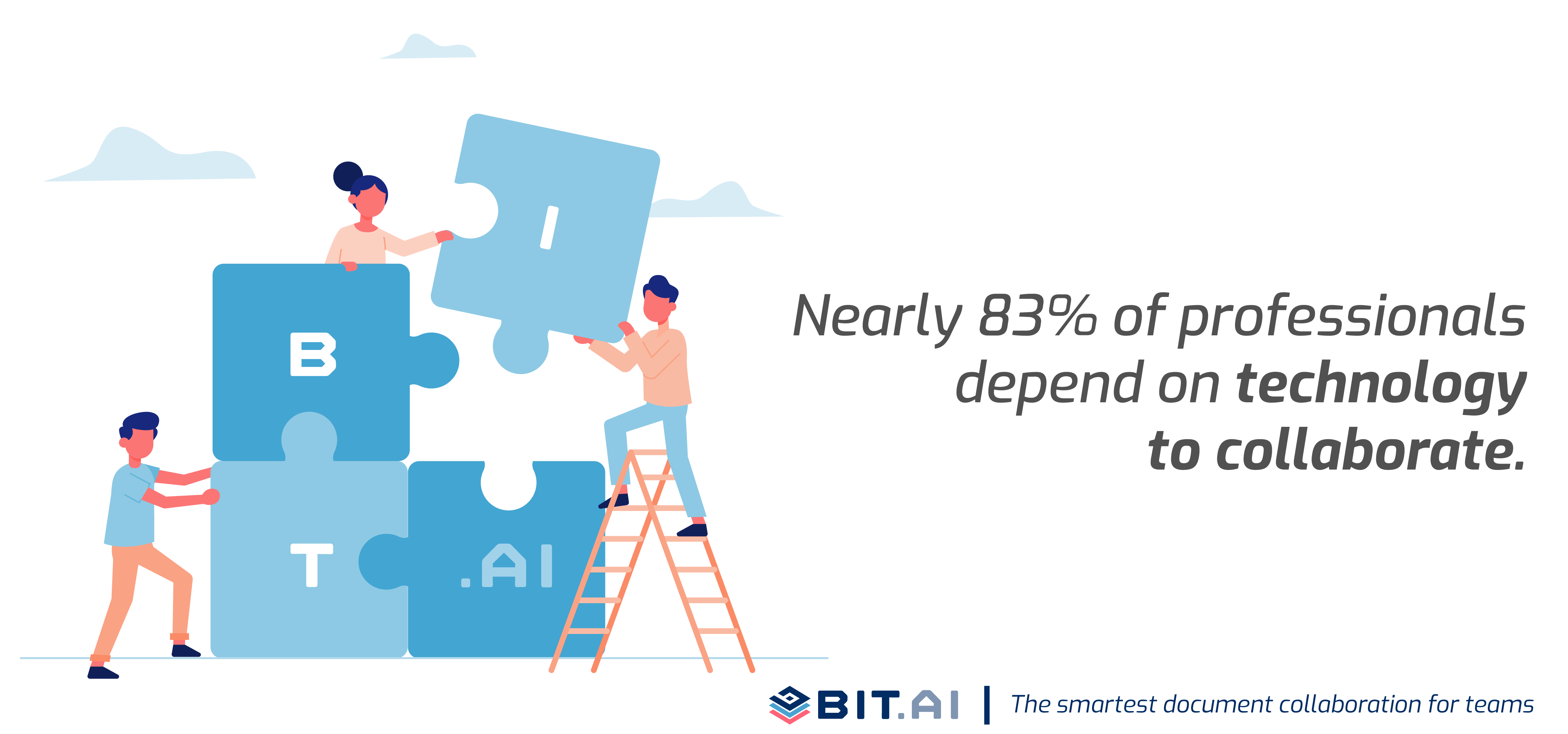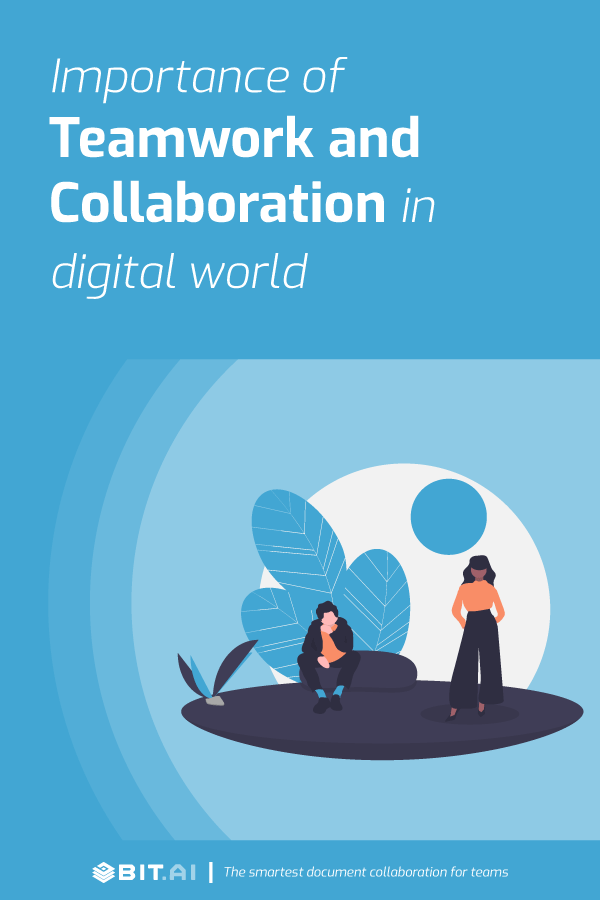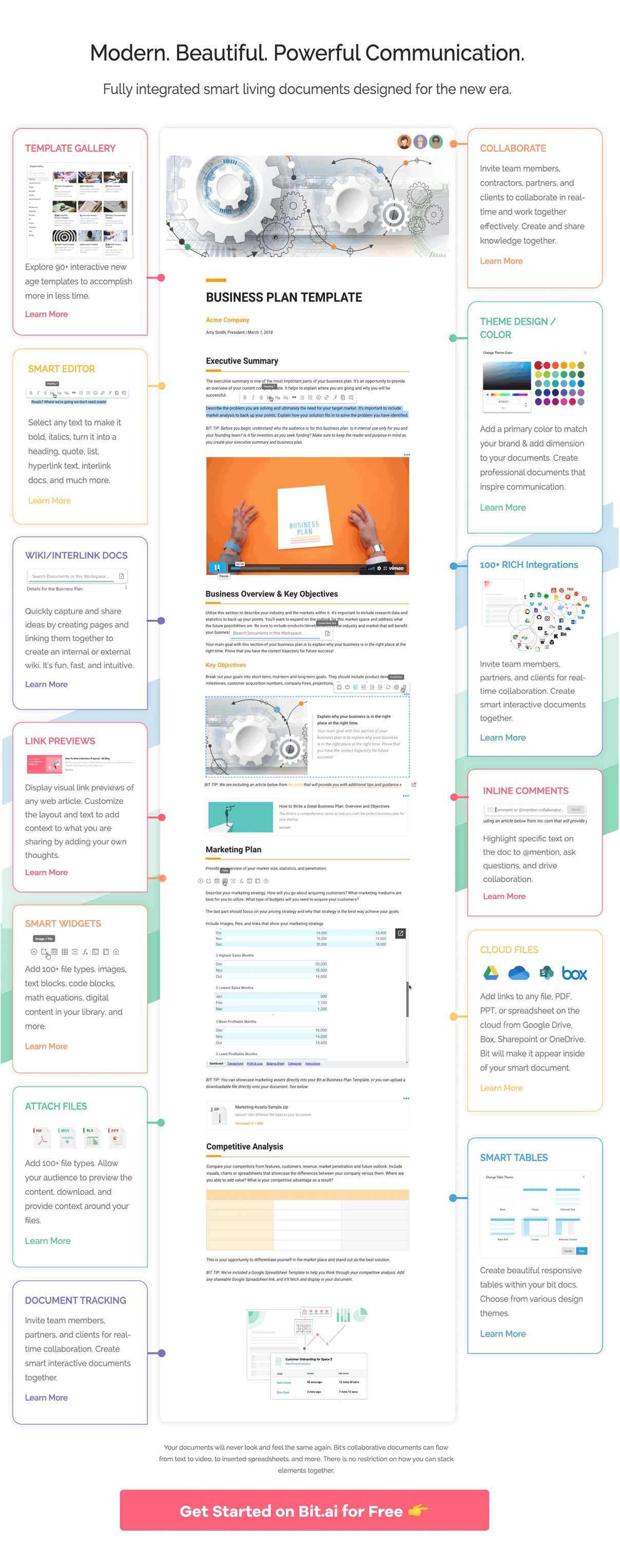Teamwork and collaboration form the fundamentals of any successful business. When employees share a common goal, combine their strengths, and help each other out when needed, an organization is bound to strive.
Collaboration and teamwork generate numerous benefits in the workplace. Some of these include:
- Improved creativity
- Faster execution of ideas
- Creates a sense of community
- Improves employee productivity and morale
- Leads to both personal and professional development
- Faster problem solving
and much more.
Teamwork and collaboration is not an opinion. Countless studies have proved the importance of healthy collaboration and teamwork in an organization and its impact on the company’s bottom line. Check out these impressive stats:
- 54% of employees say a strong sense of community (great coworkers, celebrating milestones, a common mission) kept them at a company longer than was in their best interest
- About 75% of employers rate teamwork and collaboration as “very important.”
- 86% of employees and executives cite a lack of collaboration or ineffective communication for workplace failures.
- 33% of millennials want collaborative workspaces.
- 99.1% prefer a workplace where people identify and discuss issues truthfully and effectively.
- Businesses with effective communication are 50% more likely to have lower employee turnover.
- 33% of employees say the ability to collaborate makes them more loyal.
- 33% of employees said a lack of open, honest communication has the most negative impact on employee morale.
- 37% of employees say “working with a great team” is their primary reason for staying.
However, technology is quickly changing the fundamentals of how we view teamwork and collaboration in the workplace.
From entirely changing the way we communicate and engaging with each other, to rapidly transforming the way we work.
Technological advancements have been overwhelming. In this constantly changing digital landscape, teamwork and collaboration have become challenging.
Read more: 31 Uplifting Collaboration Quotes To Ignite Successful Teamwork (Infographic Included)
Impact of Technology On Teamwork and Collaboration
Technology has infiltrated every aspect of our lives- our smartphones, laptops, tablets, smartwatches, speakers, and even our fridges are getting smarter day by day! Our workplace is no different.
From raising money for your company and brainstorming creative ideas to HR and customer service, technology has taken over every inch of business operations.
Thanks to technology, your workplace is wherever you decide to sit down. An office can be your favorite coffee shop, your couch, a bar, or a co-working space like WeWork. The lines between a physical office and the place where work actually happens are blurred.
Remote working is the norm. According to the American Community Survey, telecommuting has risen 79 percent between 2005 and 2012 and now makes up 2.6 percent of the American workforce, or 3.2 million workers.
More and more employees are now enjoying working remotely from the comfort of their homes or a coffee shop, thanks to the increased productivity and a lack of commute times.
Businesses too are enjoying better returns, empowering employees to work from wherever they want. In fact, Automattic, the company behind WordPress, closed its 15,000 sq feet San Francisco office because their ‘employees never showed up.’ Automattic gives its employees a $250/month stipend to spend on co-working spaces or for coffee at their favorite coffee shop!
By 2020, millennials will form an astounding 50% of the global workforce, it’s easier to see the technological infiltration of our workplace is only going to go up.
Technology and digitization have been game-changer. However, this has also led to newer challenges that organizations have to overcome.
Read more: What Is Workplace Collaboration And How To Do It Right
Challenges to Teamwork and Collaboration in a Digital World
Not being able to sit, talk, and communicate face-to-face can lead to a disjointed team effort. Having remote workers operating in different time zones adds even more complexity to this issue.
 Access to information (documents, files, and other important media) can be a bit difficult, especially if you still operate on paper documents.
Access to information (documents, files, and other important media) can be a bit difficult, especially if you still operate on paper documents.
Storing documents and files in the cloud can help solve the problem to an extent. However, sharing multiple cloud links with employees and making sure the right employee has given access to the right information is a time-consuming process.
Moreover, the deployment of tasks and to-do’s poses a huge problem that often creates confusion. When employees can’t see what their teammates are working on, it leads to redundancies and inefficiency in the process.
Communication is another huge hurdle in a digital workplace. Email quickly fails as we rely on it too much. Email is a poor information-sharing tool and the worst knowledge-storing repository. It’s astonishingly difficult for the receiver to find the information again once he/she consumes it.
Besides, no one else outside of the email thread can benefit from this transfer of knowledge. Thus, the same knowledge gets shared multiple times when someone needs it, adding to email overload.
Even though technology has played a huge role in improving office productivity, it still has its limitations when it comes to working together in teams and collaborating effectively.
However, a lot of digital collaboration tools have come up in the last decade, helping employees solve common problems of digitization and foster healthy collaboration.
Must Read: 50 Best Team Building Activities For Collaboration
Importance of Teamwork for better Collaboration
The adoption of software and apps, known as digital collaboration tools, has significantly gone up in modern times.
Businesses are looking for ways to set up collaborative practices in this digital era, especially since a massive 91 percent of people who work from home feel that they’re more productive than when they’re in an office.
These software tools are helping employees to collaborate on work with the aid of technology and digital devices. According to an Alfresco survey of more than 753 business professionals, it was found that nearly 83% of professionals depend on technology to collaborate.
 Nearly 82% of the participants also felt that they would feel impacted if this technology to collaborate was lost.
Nearly 82% of the participants also felt that they would feel impacted if this technology to collaborate was lost.
These digital collaboration tools not only improve communication and collaboration, but also facilitate information flow, provide ways to create and manage content, and lead to increased productivity and employee efficiency.
This also ensures that companies can function beyond geographical boundaries and regular work timings.
There is a multitude of benefits of deploying these tools in the workplace. Let’s see how they impact businesses and help foster a culture of teamwork and collaboration.
#1. Making Remote Work Possible
Remote work wouldn’t have been possible if it weren’t for these digital collaboration tools. There are software and apps for communication, document collaboration, video conferencing, holding meetings, brainstorming ideas, sharing documents, and even using whiteboards! And it’s working, according to data:
- More than 77% of people working remote report greater productivity and 52% are less likely to take time off
- About 91 percent of people who work from home feel that they’re more productive than when they’re in an office.
- Over 77 percent of remote workers get more done in fewer hours thanks to fewer distractions like meetings, conversations, and noisy coworkers.
If it weren’t for these digital tools, remote work wouldn’t have been successful, leading to more chaos than order.
Read more: 9 Must-Have Saas Tools For Remote Teams
#2. Improved Internal Communication and Collaboration
According to McKinsey, knowledge workers spend an average of 14% of their workweek in communicating and collaborating internally.
 The study also showed that improving internal collaboration through social tools could help raise the productivity of interaction by as much as 20 to 25 percent. This is huge, knowing since over 300 hours a year is wasted in inefficient or ineffective communications in the office.
The study also showed that improving internal collaboration through social tools could help raise the productivity of interaction by as much as 20 to 25 percent. This is huge, knowing since over 300 hours a year is wasted in inefficient or ineffective communications in the office.
In this fast-paced world, people can’t bear to wait for an email reply, or worse, let it get lost in their inbox.
Newer, faster communication tools- specifically instant messaging and real-time collaboration tools have provided ways to improve communication and transparency in the organization.
A collaboration tool provides a virtual space for all of your teammates to know what’s going on in the company, which in turn helps develop better interdepartmental relationships.
#3. Improved Productivity
Digital collaboration tools can help with a ton of administrative tasks in a jiffy, saving time for employees to spend time on other value-adding activities.
Thanks to remote work (which is made possible due to these collaboration tools), employees no longer have to spend hours commuting to and from the office, saving them time for leisure. Ah that ‘work-life balance.’
Moreover, having digital collaboration systems in place allows you to quickly find the information or content you are looking for, rather than shoulder tapping other employees and disturbing their workflow. All of these combined help improve office productivity and employee morale.
#4. Access to Information
You would be surprised how much time we all spend looking for information. We’re searching for content in Dropbox, searching for documents in file cabinets, or searching for an endless list of folders on your desktop.
 It all leads to an immense waste of time. According to data, almost 20% of the business time – the equivalent of one day per working week – is wasted by employees searching for information to do their job.
It all leads to an immense waste of time. According to data, almost 20% of the business time – the equivalent of one day per working week – is wasted by employees searching for information to do their job.
Collaboration tools make sure every employee has access to the information they need, when they need it, thereby improving workflows.
Tools like Bit.ai act as a central location for all documents across cloud storage systems, media, and files, etc. which employees can quickly gain access to, irrespective of their location and timezone.
#5. Improves Team Interaction
Collaboration tools enable employees to improve team interaction by providing a number of ways to communicate with each other.
Tools like Skype and Microsoft Teams have made it really easy for teams, especially the ones which are geographically scattered, to communicate with each other at via text, call, or even video.
Tools like Zoom and Google Hangouts allow you to carry out full-blown meetings, collaborate on share screens, give feedback, while others like Bit.ai allows teams to collaborate and write simultaneously on a document.
These tools open up plenty of opportunities to keep in touch with your peers at all times, increase clarity amongst employees and develop better interdepartmental relations.
#6. Knowledge Management
IDC data shows that a knowledge worker spends about 2.5 hours per day, or roughly 30% of the workday, searching for information.
 Moreover, an organization employing 1,000 knowledge workers wastes at least $2.5 to $3.5 million per year searching for non-existent information, failing to find existing information, or recreating information that can’t be found!
Moreover, an organization employing 1,000 knowledge workers wastes at least $2.5 to $3.5 million per year searching for non-existent information, failing to find existing information, or recreating information that can’t be found!
Collaboration tools like knowledge management software allow organizations to not only store all internal as well as external documents safely in one place but also document the experience and know-how of senior managers which can be used to train future hires.
In this way, the knowledge of the company does not leave when the employee does. These tools allow your current as well as future employees to access this information and get work done efficiently.
Since 44 percent of employees are either poor or very poor at transferring knowledge, knowledge management tools become the need of the hour.
#7. Improved Business Operations
Up to 80 percent of businesses use social collaboration tools for enhancing business processes.
While there are numerous tools to get work done and collaborate with your teammates, there are some digital collaboration platforms like Bit.ai which provide a one-stop-solution for employees to create content, document knowledge, chat with employees, brainstorm ideas, and share and store information, and more- helping them make decisions more swiftly.
Using such multi-featured tools allow team members to always be in the know-how of what’s happening in the company and what’s the next plan of action.
Final Words…
Collaboration and teamwork have truly taken an entirely different meaning in the digital age. Face-to-face meetings are replaced by video conferences, paper documents are replaced by word processors, while email inboxes are the new mailrooms.
From reducing the operating costs and resources to saving the most important asset of them all-time, technological advancements have provided us with a ton of upsides.
However, the sheer number of tools we use to get our work done ends up invalidating all the benefits. Having too many tools in place only leads to more confusion and chaos, often leaving us more busy than productive.
An ideal digital collaboration tool is the one that brings the work to you, not the other way around.
A virtual space where all your employees can hang out, brainstorm new and innovative ideas, communicate in real-time, store and share knowledge, and get the work done without jumping from one tool to the next.
This is what we aim to achieve with Bit. Bit.ai is completely transforming the way we interact, engage and carry out our business on a day-to-day basis by providing you a one-stop solution to your collaboration worries. Click the button below to learn more!
Further read:
Knowledge Sharing at the Workplace For Enhancing Productivity
15 Team Meeting Ideas & Topics For Your Next Meeting!
Don’t want to forget this information?
Pin it for future reference!

Related posts
Bit.ai | Watch to Learn More
What is Bit.ai?
Bit.ai is an innovative AI-driven knowledge and Document Managment suite designed to empower knowledge workers by streamlining the creation of, documents, wikis, and notes. With an intuitive interface and seamless integration, Bit.ai acts as a versatile assistant to help you collaborate, generate, organize, and visualize your ideas effortlessly. Whether you are drafting a report, managing a project, collaborating with your team or clients, or brainstorming new concepts, Bit.ai brings intelligence and creativity to every aspect of your work process.




